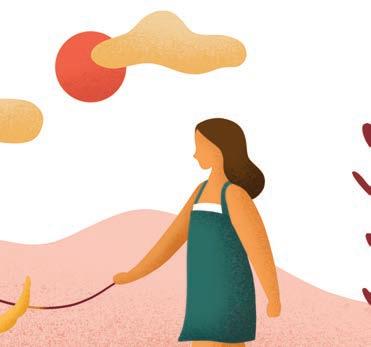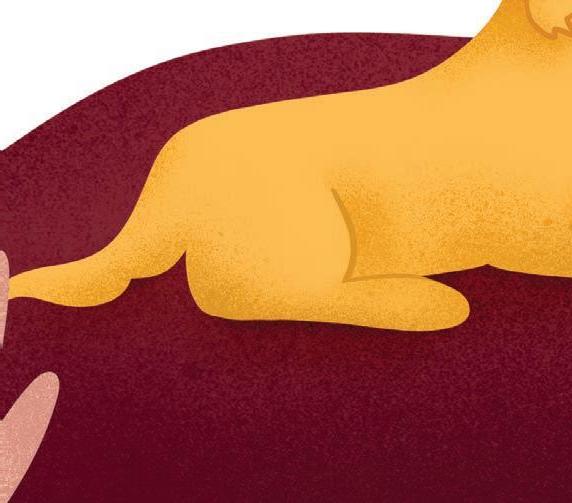
10 minute read
Life with Juniper Mae
My battle with mental illness — and the golden girl who saved me
Written by: Korah Robinson Illustrated by: Hannah Jones
Advertisement
For as long as I can remember, my mother has called me a “worrier.” I remember being young and not able to sleep because I was absolutely certain someone was going to break into my room and kidnap me.
I clearly recall my mother’s gentle frustration at my 6-year-old self. She couldn’t understand why I was always so worried about things that had a slim-to-none chance of happening. As calmly as she could, she would tell me to think of happy thoughts “like balloons and birthday parties” until I fell asleep.
And it worked. That is, until I began to face real problems: Cue middle-school hormones.

When I was a tween and young teenager, I often felt sad for no reason. I wore hoodies, never did my hair, and just sort of floated through life.
I would have never said I was depressed then because that was a “bad” thing and God forbid that you were a “bad” thing. I actually never realized what it could be until I was a sophomore in high school.
My depression was on and off, as it typically is. There were good days and bad days; there were good months and bad months. I always just wrote it off as being a teenager and going through life. Then, one day in sophomore year, all of my friends began ignoring me. To this day, I have no idea why. And that began a very dark spiral.
I didn’t really have anyone. My family and I weren’t going to church; my friends had decidedly all turned against me simultaneously; and I was left with no real relationships. Yes, my parents were there but few teenagers want to talk to their parents about their problems in high school.
I began to feel suicidal. I didn’t want to live life if this is what it was going to be like forever. I read stories about it; found the easiest ways how. All that worry from my childhood swirled with doubt, confusion and depression was too much for my 15-year-old brain to handle. I wanted to be done. I was so tired.
But, as it does for everyone, things did get better — albeit slowly. I found new friends who invited me back to church and God reached me through them when he knew I wouldn’t dare open a Bible. I began to feel safe enough to open up to them about my mental health issues and they listened and cried with me. I began to feel better. The dark thoughts were fought off with love and compassion.
But, even still, there were good days and bad days, good months and bad months.

When I left home for college, I finally had a strong support system in my friends and church leaders, but my relationship with my parents was rocky at best. We couldn’t have a single conversation without yelling one way or another. I didn’t feel any respect from them and decided they hadn’t earned mine.
I “got out” as soon as I could and moved into my cousin’s house with him, his wife and his two young daughters.
Thus began “Korah’s Depression: The Return.”
As a freshman commuter living away from home, making friends was incredibly hard. My then-boyfriend had gone to St. Louis for college and all of my friends were in my distant hometown. I felt like I had been abandoned by everyone I knew and loved — again.
I spent my freshman year of college, a time that should have been reserved for exploration and freedom, feeling trapped. I would lock myself in my room, only come to campus to attend classes and not talk to anyone face-to-face for days at a time.
I found myself crying daily and spending any moment not at school in bed. It was truly my lowest of lows. The depression was back and so were the suicidal thoughts and tendencies, as well as a new feeling I hadn’t experienced before.
I felt like I was floating, dreaming, living life outside of my body. It’s rather hard to explain but it’s almost like I was a shell of myself and was watching someone else experience my life from the outside, like I was my own ghost watching my living self interact with a world of which I was no longer a part.
Late one night, I had fallen down a hole on YouTube and rediscovered a singer-songwriter called Dodie Clark, who I remembered having enjoyed in the past. Hoping to feel some kind of joy again, I began scrolling through her videos.
I had all but given up after an hour of letting the autoplay scroll through her recent uploads when Dodie popped on screen saying, “Hi, my name is Dodie, and I feel like I’m dreaming all the time.” She went on to explain that she has a mental health condition called derealization, another term for chronic dissociation.
In that moment, it all clicked. That’s what I was feeling and it all began to make sense.

Yet, in my hurting, stubborn brain, I was convinced I didn’t need help. I would fight it on my own and I would be just fine, thank you very much.
I struggled with my mental health for the next year. My mom has always told me that happiness was a choice and it was all in my head. And that was partially true. The issue was all in my head, but not in the way she thought. And for me, happiness wasn’t a choice. I couldn’t choose to not be anxious or to wake up from the dream state in which I was stuck. I felt truly helpless.
In January, I finally caved: I was going to see a therapist. After a tumultuous Thanksgiving and Christmas break at home, I decided it was time. I booked an appointment at the CBU Counseling Center, and, starting Jan. 23, I decided to put my mental health first.
In the following weeks, I saw my therapist every Wednesday. She referred me out to a psychiatrist who could properly diagnose me and, for the first time, my “issues” had names.
I was diagnosed with a generalized anxiety disorder and depression, symptomatic of depersonalization and memory loss. I was amazed at what I learned that day. Everything I had thought was permanent began to feel like it could actually be temporary — manageable.
As time passed, my therapist, psychiatrist and I began looking into different treatment options. The medication was working well but I could tell I was missing something. While medication helped my brain work properly and encouraged serotonin, there was nothing tangible to help me feel grounded in my everyday life. I’ve never been good at grounding techniques and it was really showing itself in my therapy sessions.
Then, I found it in the form of a wet nose, countless tennis balls and an incomparable love.
Emotional Support Animals provide therapeutic support to their owners in day-to-day life. Having always loved dogs and knowing how they make me happy no matter what, I chose to look into this.
Instantly, I fell in love with the idea. Having my own personal dog to hold and love when I was having a rough day? Sign me up. I talked to my psychiatrist who gave a resounding “yes” to my idea and began paperwork with CBU.
It was finally time to look for my dog. I knew I wanted a Golden Retriever. I didn’t know why; I had never had one before. But for some reason, I got stuck on that breed. As I am very anti-breeder on principle, I knew it would be nearly impossible to find a Golden in a shelter, especially in California.
And yet.

One weekend, home from working at a camp this past summer, my best friend Liana sent me a photo of a Golden Retriever she found on our local shelter’s adoptable pets webpage.
She was a young, red Golden and, from her profile that described her as “sweet, energetic and overweight,” I knew she had to be the one, extra pounds and all.
I drove to the shelter that instant, signed in and made a beeline for the dog section. As soon as I walked in, I saw her. Her fiery hair, trapped, squirming in the metal cage, caught my eye instantly. I felt my heart leap nervously. What if she wasn’t actually perfect? What if she wasn’t the one? I approached her cage, crouched down and put my hand to the bars and was met with her wet nose.
She was the one. To this day, I am still so in awe because she was nowhere near perfect the first time I met her.
A volunteer brought her to a meet-and-greet room with me and she hid in the corner the entire time. But still, I knew. I was taking her home that day and I was naming her Juniper.
Life with Juni was definitely a learning curve at first. She was, as the webpage described, overweight. She went on a strict diet as soon as she came home. She had ticks, needed a haircut and a proper bath and I began to feel overwhelmed.
Did I make a mistake? Was Juni more of a stressor than something to provide relief in my life? It definitely felt that way at first. But over time, she has become an incredible source of relief for me.
It took Juni a while to get used to me and my daily schedule. I had to crate-train her, teach her basic obedience, and help her lose 15 pounds — all before returning to CBU for the fall. And she proved herself to be so smart and so willing to learn.
Now, Juni loves her new life and brings me and my roommates so much joy. She loves squeaky toys, expensive treats and rolling around in the grass. If she sees me overwhelmed or stressing, she comes to me and lays her head in my lap. When I’m quiet, she places her paw on my thigh or in my hand. When I lay on the ground, consumed by anxiety, stress or frustration, she lays next to me and allows me to cuddle with her until I am content.
She has become my No. 1 girl and I am constantly impressed with how much her presence truly anchors me.
Juni, more than any medication, therapist or the like, has changed my life dramatically in only four months. She cares for me unlike any person and always makes sure I’m doing OK without me asking or feeling embarrassed.
She is everything and has made my mental health journey so incredibly full.

To this day, I don’t remember much from my first two years of college. Memory loss, I later found out, is a huge side-effect of depression and anxiety. I still struggle daily with intrusive and depressive thoughts. Juni is, by no means, a cure-all. But her affection has a huge impact on my well-being.
Unfortunately, there just isn’t enough research out there for every ESA to be justified. I was fortunate to have a psychiatrist who supports them in treatment.
“Without specific training as a service animal,” says Veola Vazquez, professor of psychology, “we have very limited data about the nature of how (ESAs) are helpful or whether they actually are. Obviously, we have case reports or personal reports (but) to be able to scientifically say, ‘Yes, we know that (ESAs) are helpful,’ studies need to be done.”
However, Vazquez says that, while there isn’t much research surrounding ESAs, certain ideas can be inferred about an animal’s affect on mental health.
“If you’re experiencing any anxious or depressive symptoms, there is a lot of evidence that being able to develop a sense of mindfulness where you cultivate attention to your breathing, attention to your surroundings and being very present and focused can help reduce those symptoms,” Vasquez says. “If the animal comes alongside you and helps with that process, that can be very helpful.
"Do we have a lot of evidence as far as the literature goes in that? No. But is the process of using mindfulness techniques proven to be helpful? Absolutely.”
Though they aren’t necessarily backed by science yet, my emotional support animal has changed my experience in life and college drastically. For those reading this and resonating with my story, I implore you to seek help and find a treatment plan that works for you. Only good things can come from looking to better one’s self.









